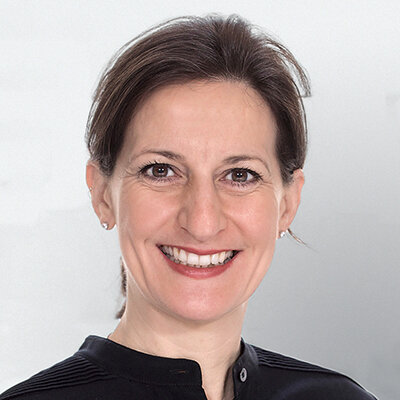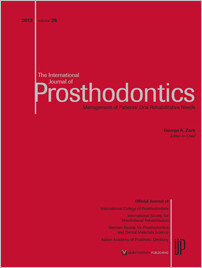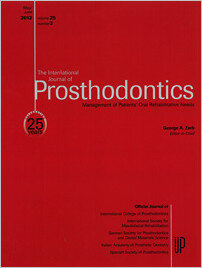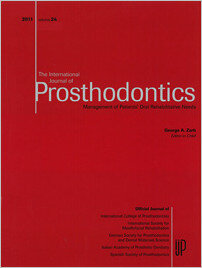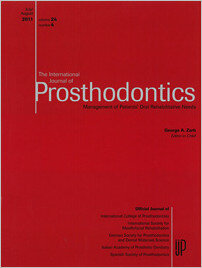PubMed ID (PMID): 23626972Pages 210-213, Language: EnglishChaytor, DouglasThe impact of implant therapy on our discipline clearly let the genie out of the bottle. This helped break down specialty-driven silos in assessing patients' overall oral health needs, rather than reinforce them. The result was a new treatment planning orthodoxy that is gradually becoming a powerful antidote to old discipline-contrived dogmas. Regrettably, the traditionally strong educational emphasis on the topic of occlusion and its role in crafting optimal treatment plans for patients had already started to weaken when osseointegration entered the modern lecture circuit's priority rankings. This was unfortunate since an appreciation for occlusion's role in treatment planning remains such an obvious focus for integrating diverse and often conflicting treatment agendas. While scope for rehabilitating oral function resulted from predictable implant therapy, accompanying developments in surgical and prosthodontic skills were not matched by a comparable increase in our understanding of the resultant functional aspects. The neurophysiologic response to osseointegrated implants remains elusive and certainly underestimated. Which is why the current explosion of research interest in neuroplasticity is bound to make significant inroads into dentistry's better understanding of so-called osseoperception. Throughout the last half century, numerous clinical scholars in different leading dental schools around the world devoted their academic lives to the study of occlusion. They laid down the road map for our current appreciation of the complexity of masticatory function and parafunction, and are now arguably best known to those of us whose own learning and teaching growth benefitted from their shared wisdom and unique capacity for guiding and promoting. Donald Kepron is one such exemplar of intellectual courage and integrity; and his inadequately recognized contribution to Canadian prosthodontics demands special acknowledgment in 2013-the year he retired from practice following his earlier retirement from his academic role at the Faculty of Dentistry, McGill University in Montreal, Quebec, Canada. I therefore invited Douglas Chaytor, long retired from his Dalhousie University prosthodontic chairmanship in Nova Scotia, and a past secretary of the International College of Prosthodontists, to interview Don Kepron. All three of us have been friends for many decades and shared a recent reunion to celebrate our role in the founding of the Association of Prosthodontists of Canada, which took place in Ottawa in 1971.
PubMed ID (PMID): 23855059Pages 215, Language: EnglishRosenstiel, Stephen F.DOI: 10.11607/ijp.3406, PubMed ID (PMID): 23626973Pages 218-226, Language: EnglishLayton, Danielle M.Purpose: This paper aims to explore the mathematics of Kaplan-Meier and survival statistics, explain how the mathematics are relevant for prosthodontic treatment planning, and provide advice for future presentation of such data.
Materials and Methods: The mathematics of the Kaplan-Meier and related survival statistic formulas were explored with hypothetical data consisting of 100 prostheses, reviewed yearly for 10 years. The hypothetical impact of failures (n = 1, 2, 9, or 0) and censored data (n = 5, 9, or 10) were reviewed across three life tables and survival curves. Actual published data of 304 porcelain veneers, reviewed regularly for 16 years, were similarly utilized. The impact of changing the number of failures and censored data on the estimated cumulative survival (ECS) and the standard error (SE) was reviewed across two life tables and survival curves.
Results: The ECS and SE are calculated from two data figures: the number of failures that occurred during an interval and the number of prostheses at risk during that same interval. The ECS reduces and its SE enlarges when prostheses fail. These results can also change if prostheses are lost from the study (censored). However, the number of failures is in the numerator of the equation. Therefore, if no failures occur, loss of prostheses from the study cannot change the ECS or the SE. This can dramatically affect the calculated ECS and SE if a prosthesis becomes lost to follow-up rather than presenting as a failure. The hypothetical and actual data were used to explore these concepts.
Conclusion: Current techniques for analysis of time-to-event data are imperfect and can be misleading. It therefore behooves authors to strive to improve reporting transparency, journals to support such industry, and readers to remain mindful that the cumulative survival is an estimate, ie, a reflection of reality.
DOI: 10.11607/ijp.3167, PubMed ID (PMID): 23626974Pages 227-229, Language: EnglishPanjwani, Bella / Cable, Cheryl / Flores-Mir, Carlos / Bhargava, KashyapPalatal rugae have been suggested as a stable landmark and potential biometric guide for positioning anterior maxillary teeth. This study aimed to evaluate the use of palatal rugae as a biomarker by establishing mathematical correlations with anterior maxillary dental arch geometry and tooth positions. One hundred dental casts were obtained from fully dentate individuals with normal occlusal relationships. Thirteen reference points were analyzed. Significant correlations were found between measurements in the anterior dental segment and palatal rugae measurements. Those correlation coefficients were, however, low. Although some correlation values obtained were statistically significant, they are not likely to have significant clinical predictive value.
DOI: 10.11607/ijp.2768, PubMed ID (PMID): 23626975Pages 230-234, Language: EnglishÖzyoney, Gürol / Yanıkoglu, Funda / Tagtekin, Dilek / Hayran, OsmanPurpose: This study evaluated the 4-year clinical performance of IPS Empress II ceramic onlay restorations on extensively restored, endodontically treated molars.
Materials and Methods: A sample of 53 morphologically compromised and endodontically treated molar teeth were restored with IPS Empress II ceramic onlays cemented with a dualcured luting composite. The molars were evaluated by two experienced clinicians in accordance with the modified United States Public Health Service criteria at baseline and 6-month recalls up to a 4-year observation period. The analyses were carried out using the Wilcoxon signed-rank test and the Kaplan-Meier product limit method.
Results: Four failures were noted. Two onlays debonded; one was reinserted and reluted while the other resulted in lost coronal hard tissue and was restored with a fiberreinforced post-and-core system followed by a full ceramic crown restoration. The third failure resulted from secondary caries and fracture of the remaining enamel and was restored with a full ceramic crown. The fourth failure was extracted. None of the onlays exhibited wear, fracture of antagonist teeth, or dimensional change at proximal contacts.
Conclusion: Within the limitations of this study's design and short 4-year observation period, IPS Empress II ceramic onlay restorations demonstrated promising results with a 92.5% success rate.
DOI: 10.11607/ijp.3254, PubMed ID (PMID): 23626976Pages 235-238, Language: EnglishYilmaz, Burak / Mess, Joseph / Seidt, Jeremy / Clelland, Nancy L.The aim of this study was to compare strains generated by splinted and nonsplinted cement-retained implant crowns for two implants. A stereolithic resin cast was printed using computed tomography scan data from a patient. Two 4 X 6-mm implants were placed in the posterior left side of the cast. Splinted and nonsplinted cementretained crowns were made. The three-dimensional image correlation technique was used for the measurement of strains as crowns were loaded up to 400 N in vertical and oblique directions with an Instron machine. Patterns and magnitudes of strain for splinted and nonsplinted crowns were similar. Results of this in vitro study suggest that splinting has a minimal effect on the load sharing of adjacent cementretained crowns.
DOI: 10.11607/ijp.3305, PubMed ID (PMID): 23626977Pages 239-243, Language: EnglishMizumori, Takahiro / Sumiya, Masakazu / Kobayashi, Yasuyoshi / Inano, Shinji / Yatani, HirofumiPurpose: To investigate the hypothesis that sleep bruxism (SB) events could be predicted by an increase in heart rate.
Materials and Methods: Fourteen sleep bruxers were recruited. Each participant recorded his or her own electromyography (EMG) and electrocardiography (ECG) at home for 2 consecutive nights using a portable telemetry system. Ten heartbeats before (B10 to B1) and three heartbeats after (A1 to A3) the onset of SB events were analyzed, and the threshold for the prediction of an SB event was determined. The validity of the threshold was tested by EMG and ECG recorded in the same manner for an additional night. The prediction accuracy of SB events was evaluated for sensitivity and specificity.
Results: A gradual increase in heart rate was observed before an SB event, and B1, A1, A2, and A3 were significantly higher than B10 (P .01). The threshold value was set at 110% when the mean of all heart rates of the second night of recording was set at 100%. A total of 324 SB events were observed and 299 were preceded by increased heart rate that exceeded the threshold (sensitivity, 92.3%). The total number of increased heart rate events was 1,239, and the total number of threshold applications was estimated to be 120,000. The specificity was 99.2%.
Conclusion: Over 90% of SB events could be predicted by an increasing heart rate of 110%. Since the sensitivity and specificity were extremely high, the hypothesis that SB events could be predicted by increased heart rate was positively verified.
DOI: 10.11607/ijp.3044, PubMed ID (PMID): 23626978Pages 244-249, Language: EnglishHarel, Noga / Piek, Dana / Livne, Shiri / Palti, Ady / Ormianer, ZeevPurpose: The aim of this study was to compare the effects of immediate loading (IL) and delayed loading (DL) on peri-implant crestal bone loss around maxillary implants after long-term functioning.
Materials and Methods: A retrospective chart review was conducted to assess the outcomes of 110 tapered, multithreaded implants placed for the treatment of one or more missing and/or unsalvageable teeth in the maxilla of 23 patients. Implants were assigned to either the DL or IL database according to loading time. Marginal bone changes were calculated using standardized radiographs taken at implant placement (baseline) and during annual follow-ups.
Results: One implant failed in the DL group. After a mean follow-up of 111 months in the DL group and 119 months in the IL group, cumulative implant survival was 99.09% (DL = 98.11%, IL = 100%). No observable bone loss was evident in 83.49% of the surviving implants. Cumulative success rates were 100% for the IL group and 98.11% for the DL group.
Conclusions: Immediately loaded maxillary implants showed long-term results comparable to delayed loaded maxillary implants.
DOI: 10.11607/ijp.3266, PubMed ID (PMID): 23626979Pages 250-259, Language: EnglishReissmann, Daniel R. / Hacker, Tim / Farhan, Daniel / Heydecke, GuidoPurpose: To develop and validate an instrument for the assessment of patient-based measures of process-related quality of care in prosthodontic patients.
Materials and Methods: In this nonrandomized study, the new Burdens in Prosthetic Dentistry Questionnaire (BiPD-Q) was developed in two steps using a total of 128 prosthodontic patients in a mixed-method approach, combining quantitative-qualitative methodologies. First, the item pool for the instrument was created using semistructured interviews and a group of experts in prosthodontics. This resulted in a preliminary version of the questionnaire. Second, an assessment of redundancy, completion rates, face validity, difficulty, and distribution of the core set of the items was performed. The final version of the BiPD-Q had psychometric core properties (reliability and validity) evaluated.
Results: The BiPD-Q consisted of 25 items. Reliability was satisfactory (Cronbach's alpha = .87). The mean score of all items of the BiPD-Q was significantly correlated with mean perceived burdens during treatment as rated by the clinician (r = 0.26; P .01) and with overall satisfaction with the treatment procedures as rated by patients (r = .31; P .01), indicating sufficient convergent validity.
Conclusion: A reliable and valid instrument for the assessment of patient-based process-related quality of care in prosthodontics has been developed. The BiPD-Q allows comparisons of different dental procedures within a treatment course and of different treatment providers. The use of this type of questionnaire appears to be a valuable tool for dental health care research. The outcomes of research using the BiPD-Q may result in a more pleasant treatment experience for future patients.
DOI: 10.11607/ijp.3120, PubMed ID (PMID): 23626980Pages 260-264, Language: EnglishYamazaki, Seiya / Arakawa, Hikaru / Maekawa, Kenji / Noda, Kinji / Hara, Emilio Satoshi / Minakuchi, Hajime / Sonoyama, Wataru / Matsuka, Yoshizo / Kuboki, TakuoPurpose: To compare the complication rate of natural teeth adjacent to implantsupported dentures (IFDs) with that of teeth serving as abutments for fixed partial dentures (FPDs). The second goal was to assess the risk factors for complications in teeth adjacent to bounded edentulous spaces.
Materials and Methods: The study subjects were selected from patients who received prosthodontic treatment for their bounded edentulous space not exceeding two missing teeth between February 1990 and March 2007. Sixty-one patients were included in the IFD group and 66 patients were included in the FPD group. Tooth complications were defined as tooth extraction, periodontal lesion, periapical lesion, and loss of prosthesis and were assessed by one examiner based on dental records.
Results: The 8-year cumulative complication rate for the IFD group (7.9%) was significantly lower than for the FPD group (40.7%). Additionally, the 8-year cumulative complication rate of vital teeth (6%) was significantly lower than that of nonvital teeth (45.9%). A cox proportional hazard analysis revealed that nonvitality of dental pulp was a significant risk factor for tooth complications, whereas treatment modality was not.
Conclusions: Teeth adjacent to IFD-treated edentulous spaces presented fewer complications than natural teeth serving as abutments for FPDs. Conservation of teeth adjacent to edentulous spaces as vital teeth was the key finding to limit further tooth loss.
DOI: 10.11607/ijp.3410, PubMed ID (PMID): 23626981Pages 265-267, Language: EnglishDhima, Matilda / Rieck, Kevin L. / Arce, Kevin / Salinas, Thomas J.Excessive soft tissue bulk, movement, chronic inflammation, and hypertrophy in periimplant areas pose challenges for long-term management of peri-implant soft tissues surrounding osteocutaneous flap reconstructions. A case history report is presented on the predictable establishment of stable peri-implant soft tissue and improved mentolabial sulcus depth in a patient treated for high-grade osteosarcoma of the mandible. Following surgical resection, reconstruction with osteocutaneous fibula free flap, and endosseous implant placement, a combined surgical and prosthetic approach was used through a lip switch vestibuloplasty and an implant-retained soft tissue conformer.
DOI: 10.11607/ijp.2970, PubMed ID (PMID): 23626982Pages 268-271, Language: EnglishQian, Yumei / Qian, Haixin / Wu, Yadong / Jiao, TingThis study investigated upper airway aerodynamic characteristics of patients who underwent maxillectomy using three-dimensional reconstruction and computational fluid dynamics. The results revealed the generation of low-velocity vortices throughout the entire maxillary defect during respiration. The nasal structure on the nonsurgical side changed postsurgically, possibly due to the pressure gradient between the defective and healthy side. The bilateral disturbed airflow patterns are believed to be the cause of common symptoms. The numeric simulation technique could be used as a potential method to understand upper airway morphology changes and respiratory functions, thus guiding the fabrication of prostheses.
DOI: 10.11607/ijp.3287, PubMed ID (PMID): 23626983Pages 272-276, Language: EnglishKlink, Andrea / Huettig, FabianA total of 163 monolithic restorations made from Vitablocs Mark II and luted adhesively or with resin cement were followed up for 3 to 70 months. Recall consisted of an evaluation of complete dental and hygiene status as well as quality assessment. Seven of 35 patients were lost to follow-up. Ninety-one percent of the 37 crowns, 23 partial crowns, and 89 inlays evaluated were in the posterior region. Combined survival estimate was 0.92 at the 48-month median observation time. Inlays and partial crowns performed well. Prevalence of complication and failure was highest for crowns (CP = 37.8%, FP = 21.6%). The results demonstrate that success relates to patient factors and restoration type, not luting protocol.
DOI: 10.11607/ijp.2903, PubMed ID (PMID): 23626984Pages 277-281, Language: EnglishOsman, Reham B. / Payne, Alan G. T. / Duncan, Warwick / Ma, SunyoungLimited clinical research identifies prosthodontic perspectives of novel designs for zirconia implants supporting overdentures. Four pilot study participants were selected before a planned randomized clinical trial on zirconia implants supporting overdentures. Novel designs for maxillary four-implant overdentures (quadrilateral design) and mandibular three-implant overdentures (tripodal design) were used with 28 implants (maxilla, n = 16; mandible, n = 12). Four implants failed to achieve osseointegration prior to loading. At the 1-year follow-up appointment, all implants were surviving, the overdentures were in function, and there were no clinical signs of wear of the attachment system. A proof-of-principle for prosthodontic perspectives of a novel design using one-piece zirconia implants supporting maxillary and mandibular implant overdentures was achieved.
DOI: 10.11607/ijp.2995, PubMed ID (PMID): 23626985Pages 282-287, Language: EnglishTanaka, Yasue / Hattori, YoshinoriPurpose: To develop a method for capturing the three-dimensional (3D) shapes of dental arches in a position relative to that of maximum intercuspation and to evaluate its dimensional and occlusal accuracy.
Materials and Methods: The conventional custom-tray impression technique was used to capture detailed and dimensionally accurate impressions of individual teeth, and a modified bite-registration technique was used to register the relative positions of the maxillary and mandibular teeth in maximum intercuspation. It was hypothesized that this procedure may help to eliminate the occlusal inaccuracy caused by mouth opening-induced mandibular flexion. Two types of rigid frames (buccal and palatal) were used to prevent deformation of the interocclusal record. Their effects were tested on an articulated full-arch master cast and compared in terms of dimensional accuracy. In addition, the procedure was applied to a healthy volunteer to visually evaluate occlusal accuracy based on the form and distribution of the occlusal contacts.
Results: The mean decrements of the dental arch width were 0.037 ± 0.017 mm and 0.269 ± 0.114 mm when using the palatal and buccal frames, respectively. The dimensional accuracy of the palatal frame was comparable to that of the custom-tray impression technique. The form and distribution of the occlusal contacts between the 3D dental arches were similar to those observed in the transilluminated image of the interocclusal record, indicating the occlusal accuracy of this method.
Conclusion: The dimensional and occlusal accuracy of the method proposed here is suitable for clinical application when used in combination with the palatal frame.



